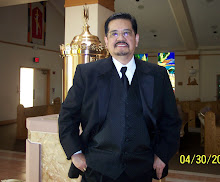My mother taught me my evening prayer. It is a simple prayer of thanks for having gone through a full day and a prayer to see the beautiful morning after. It is a prayer of thanks for having been given good health for the day and a summon for help in serving the Lord and parents.
It is a kid's prayer which I faithfully recite even as an adult, night after night and also on mornings of each day.
Prayers are powerful, that I learned from an early age.
When we were kids, we'd also been taught a prayer by an aunt to be recited during calamities and emergencies. It is a prayer in song.
I remember me and my siblings and cousins singing it during play times on hot summer days in Manila which were interrupted by strong rains, usually in May.
I remember singing it on a late evening, lonesome trip along the long stretch of Pennsylvania turnpike, a trip punctuated by heavy snow and fog. It was Thanksgiving Eve and I was headed to Ohio to celebrate the Day with my sister and her family.
 |
| Winter storm hazardous driving |
Even now, I still cry at how my prayers have been answered faithfully by Our Lord. And I marvel at His greatness and compassion for He never fails to show His presence by giving in even to the small, sometimes mundane things we ask from Him.
People relatively unknown to me regularly ask for prayers for someone who's sick or dying, or for problems big and small. I never fully understood why.
Then I heard a priest told a congregation how easy it is to pray in times of joy and financial boom, but wait when it's time of bad luck and illness and economic downturn. That's the time when it's most difficult to pray to and praise God.
That's why we need to pray for those who are in distress - health wise, financial-wise, spiritually-wise, because they are having a hard time praying for themselves.
That's probably why praying for someone has become a big business these days.
People in Manila frown at those "prayer-ladies" lined up outside the
Basilica of Senor Nazareno in Quiapo, who pray for and with people in exchange for pennies or dimes. Once, we went to the Shrine of Padre Pio in Eastwood and found also individuals outside the premises asking for money in exchange for prayers.
But what about those high-end, televised worship groups who'd pray for people and then beg for regular contribution and donations? Like the lowly prayer-ladies of Quiapo, they also prey on the prayer needs of those who are sick and troubled.
Of late,
prayer warriors have entered the vocabulary.
One website describes "Prayer warriors are Christian-based group of
family, friends and total strangers coming together to
prayerfully support one another in times of need, as well as in
thanksgiving, and in celebration. The Prayer Warriors believe God hears
every prayer. He answers prayers in His own way and in His own time."
Let's remember what the Good News proclaims, in Matthew 18: 19-20, " Again (amen) I say to you, if two of you agree on earth about anything for which they are to pray, it shall be granted to them by my Heavenly Father. For where two or three are gathered in my name, there am I in the midst of them."


























































